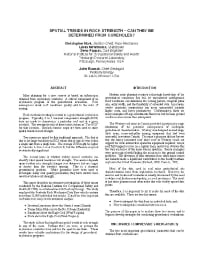Mining Publication: Spatial Trends in Rock Strength - Can They Be Determined From Coreholes?
Original creation date: August 2004
Authors: C Mark, LJ Mcwilliams, DM Pappas, J Rusnak
NIOSHTIC2 Number: 20025353
Proceedings of the 23rd International Conference on Ground Control in Mining, August 3-5, 2004, Morgantown, West Virginia. Peng SS, Mark C, Finfinger GL, Tadolini SC, Heasley KA, Khair AW, eds., Morgantown, WV: West Virginia University, 2004 Aug; :177-182
Mine planning for a new reserve is based on information obtained from exploratory coreholes. A critical component of an exploration program is the geotechnical evaluation. Poor assumptions about roof conditions greatly add to the risks of mining. Rock mechanics testing is central to a geotechnical exploration program. Typically, 3 to 5 uniaxial compressive strength (UCS) tests are made to characterize a particular roof unit at a given corehole. The average (mean) of these tests is taken as "The UCS" for that location. Isopach contour maps are then used to show spatial trends in roof strength. Two issues are raised by this traditional approach. The first is due to the large variability in UCS values that is typical even within a single unit from a single hole. The average UCS might be higher at Corehole A than it is at Corehole B, but the difference may not be statistically significant. The second issue is whether widely spaced coreholes can identify valid spatial trends in rock strength. The answer depends upon whether rock strength changes over distances that are longer or shorter than the corehole spacing. This is a classical geostatistical problem. While geostatics have been used to investigate many coal quality parameters, they have seldom been used to evaluate rock strength. This paper describes an extensive investigation of these issues conducted by the National Institute for Occupational Safety and Health (NIOSH) in collaboration with Peabody Energy. The study employed the Peabody Rock Mechanics Data Base which contains more than 10,000 individual test results. Data from four important roof units were subjected to statistical analysis: Brereton Limestone above the Herrin 6 seam (Illinois), Turner Mine Shale above the No. 9 Seam (Kentucky), Sandstone above the Eagle Coal (West Virginia), and Shale above the Eagle Coal (West Virginia). The study did not find significant spatial trends in rock strength in any of the cases. Perhaps there are none, or perhaps the exploration coreholes were just too far apart to see them. These results have valuable implications for the design of geotechical exploration programs.

NIOSHTIC2 Number: 20025353
Proceedings of the 23rd International Conference on Ground Control in Mining, August 3-5, 2004, Morgantown, West Virginia. Peng SS, Mark C, Finfinger GL, Tadolini SC, Heasley KA, Khair AW, eds., Morgantown, WV: West Virginia University, 2004 Aug; :177-182
- Correlation of Sonic Travel Time to the Uniaxial Compressive Strength of U.S. Coal Measure Rocks
- Elastic and Shear Moduli of Coal Measure Rocks Derived from Basic Well Logs Using Fractal Statistics and Radial Basis Functions
- Electromagnetic Noise in Itmann Mine
- In Situ Estimation of Roof Rock Strength using Sonic Logging
- Methods of Determining the Orientations of Bedrock Fracture Systems in Southwestern Pennsylvania and Northern West Virginia
- Pillar Mechanics of Coal Mine Bursts: A Control Strategy
- Reservoir Rock Properties of Coal Measure Strata of the Lower Monongahela Group, Greene County (Southwestern Pennsylvania), from Methane Control and Production Perspectives
- Roof Support
- Shear Mechanism for Mining-Induced Fractures Applied to Rock Mechanics of Coal Mines
- Volumetric Measurement of Rock Movement Using Photogrammetry